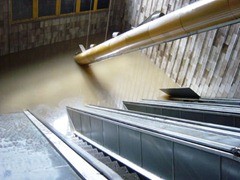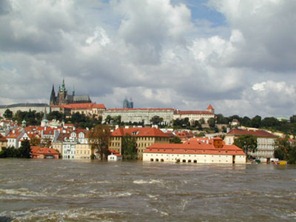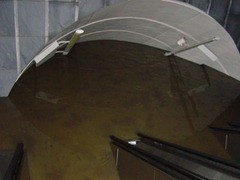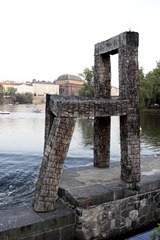Prague floodings in 2002

In August of 2002, the Czech Republic suffered major flooding, one of the worst natural disasters that this country has seen. The floods, which in some places reached levels that had not been seen in 500 years, covered more than a third of the country and took the lives of 17 people.
The water caused more than 73, 000, 000, 000Kč (73 thousand million Czech Korunas = 200 million euros = 180 million pounds) worth in damages. After a year, life returned to moral in the affected zones. Today, there is evidence left by the high water levels that can be seen on some metro station walls.
The river Moldava reached a volume level of 6, 000m3 of water per second, the highest Prague has ever seen.

Along the banks of the river Moldava at the highest bridge Carlos mobile protective barriers were installed as quickly as possible.
During the night of the 13th-14th August in 2002, the river rose to a critical level, just 10cm below the edge of the protective barrier. These barriers contributed massively in saving the historic city of Prague.
The river stopped the metro in 2002. There were 17 stations under water, mostly in the centre. The flooding revealed the terrible flaws in the protection systems of the metro.

More than a thousand buildings in the area of Karlín were affected by the water. The motorways and pavements had sunk and some houses had to be demolished. The situation in Karlín was quite tragic according to the inhabitants of the area.

A similar situation occurred in the area of Malá Strana where the water affected many historical houses. The flooding put the gallery Sovovy Mlýny in danger as well, taking away a gigantic chair from the patio which was a piece by a famous Czech artist Magdalena Jetelová. A little while later, the chair was found about 40 kilometres away from Prague.
The flooding also resulted in many museums and libraries being affected, including the Nacional Library of the Czech Republic which holds books and documents of great historical importance. Many of these were saved, but a few of them were lost forever.
Photo gallery
Content available in other languages
- Español: Inundaciones de 2002 en Praga
Want to have your own Erasmus blog?
If you are experiencing living abroad, you're an avid traveller or want to promote the city where you live... create your own blog and share your adventures!
I want to create my Erasmus blog! →

















Comments (0 comments)